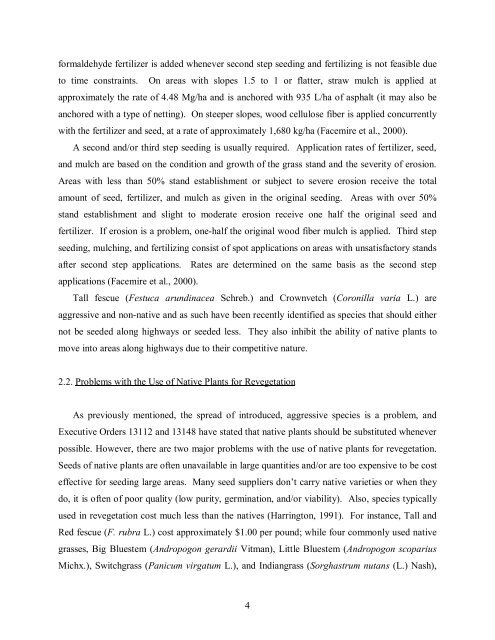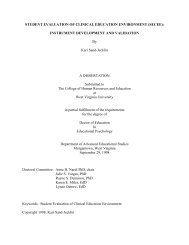The Use of Native Plants for Revegetation along West Virginia ...
The Use of Native Plants for Revegetation along West Virginia ...
The Use of Native Plants for Revegetation along West Virginia ...
You also want an ePaper? Increase the reach of your titles
YUMPU automatically turns print PDFs into web optimized ePapers that Google loves.
<strong>for</strong>maldehyde fertilizer is added whenever second step seeding and fertilizing is not feasible due<br />
to time constraints. On areas with slopes 1.5 to 1 or flatter, straw mulch is applied at<br />
approximately the rate <strong>of</strong> 4.48 Mg/ha and is anchored with 935 L/ha <strong>of</strong> asphalt (it may also be<br />
anchored with a type <strong>of</strong> netting). On steeper slopes, wood cellulose fiber is applied concurrently<br />
with the fertilizer and seed, at a rate <strong>of</strong> approximately 1,680 kg/ha (Facemire et al., 2000).<br />
A second and/or third step seeding is usually required. Application rates <strong>of</strong> fertilizer, seed,<br />
and mulch are based on the condition and growth <strong>of</strong> the grass stand and the severity <strong>of</strong> erosion.<br />
Areas with less than 50% stand establishment or subject to severe erosion receive the total<br />
amount <strong>of</strong> seed, fertilizer, and mulch as given in the original seeding. Areas with over 50%<br />
stand establishment and slight to moderate erosion receive one half the original seed and<br />
fertilizer. If erosion is a problem, one-half the original wood fiber mulch is applied. Third step<br />
seeding, mulching, and fertilizing consist <strong>of</strong> spot applications on areas with unsatisfactory stands<br />
after second step applications. Rates are determined on the same basis as the second step<br />
applications (Facemire et al., 2000).<br />
Tall fescue (Festuca arundinacea Schreb.) and Crownvetch (Coronilla varia L.) are<br />
aggressive and non-native and as such have been recently identified as species that should either<br />
not be seeded <strong>along</strong> highways or seeded less. <strong>The</strong>y also inhibit the ability <strong>of</strong> native plants to<br />
move into areas <strong>along</strong> highways due to their competitive nature.<br />
2.2. Problems with the <strong>Use</strong> <strong>of</strong> <strong>Native</strong> <strong>Plants</strong> <strong>for</strong> <strong>Revegetation</strong><br />
As previously mentioned, the spread <strong>of</strong> introduced, aggressive species is a problem, and<br />
Executive Orders 13112 and 13148 have stated that native plants should be substituted whenever<br />
possible. However, there are two major problems with the use <strong>of</strong> native plants <strong>for</strong> revegetation.<br />
Seeds <strong>of</strong> native plants are <strong>of</strong>ten unavailable in large quantities and/or are too expensive to be cost<br />
effective <strong>for</strong> seeding large areas. Many seed suppliers don’t carry native varieties or when they<br />
do, it is <strong>of</strong>ten <strong>of</strong> poor quality (low purity, germination, and/or viability). Also, species typically<br />
used in revegetation cost much less than the natives (Harrington, 1991). For instance, Tall and<br />
Red fescue (F. rubra L.) cost approximately $1.00 per pound; while four commonly used native<br />
grasses, Big Bluestem (Andropogon gerardii Vitman), Little Bluestem (Andropogon scoparius<br />
Michx.), Switchgrass (Panicum virgatum L.), and Indiangrass (Sorghastrum nutans (L.) Nash),<br />
4












